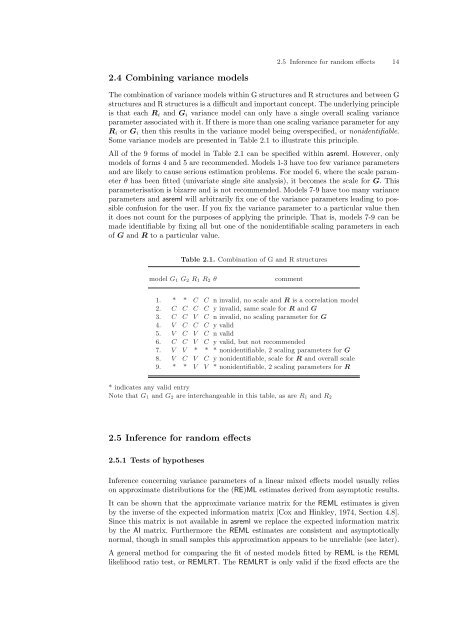ASReml-S reference manual - VSN International
ASReml-S reference manual - VSN International
ASReml-S reference manual - VSN International
- No tags were found...
Create successful ePaper yourself
Turn your PDF publications into a flip-book with our unique Google optimized e-Paper software.
2.5 Inference for random effects 142.4 Combining variance modelsThe combination of variance models within G structures and R structures and between Gstructures and R structures is a difficult and important concept. The underlying principleis that each R i and G i variance model can only have a single overall scaling varianceparameter associated with it. If there is more than one scaling variance parameter for anyR i or G i then this results in the variance model being overspecified, or nonidentifiable.Some variance models are presented in Table 2.1 to illustrate this principle.All of the 9 forms of model in Table 2.1 can be specified within asreml. However, onlymodels of forms 4 and 5 are recommended. Models 1-3 have too few variance parametersand are likely to cause serious estimation problems. For model 6, where the scale parameterθ has been fitted (univariate single site analysis), it becomes the scale for G. Thisparameterisation is bizarre and is not recommended. Models 7-9 have too many varianceparameters and asreml will arbitrarily fix one of the variance parameters leading to possibleconfusion for the user. If you fix the variance parameter to a particular value thenit does not count for the purposes of applying the principle. That is, models 7-9 can bemade identifiable by fixing all but one of the nonidentifiable scaling parameters in eachof G and R to a particular value.Table 2.1. Combination of G and R structuresmodel G 1 G 2 R 1 R 2 θcomment1. * * C C n invalid, no scale and R is a correlation model2. C C C C y invalid, same scale for R and G3. C C V C n invalid, no scaling parameter for G4. V C C C y valid5. V C V C n valid6. C C V C y valid, but not recommended7. V V * * * nonidentifiable, 2 scaling parameters for G8. V C V C y nonidentifiable, scale for R and overall scale9. * * V V * nonidentifiable, 2 scaling parameters for R* indicates any valid entryNote that G 1 and G 2 are interchangeable in this table, as are R 1 and R 22.5 Inference for random effects2.5.1 Tests of hypothesesInference concerning variance parameters of a linear mixed effects model usually relieson approximate distributions for the (RE)ML estimates derived from asymptotic results.It can be shown that the approximate variance matrix for the REML estimates is givenby the inverse of the expected information matrix [Cox and Hinkley, 1974, Section 4.8].Since this matrix is not available in asreml we replace the expected information matrixby the AI matrix. Furthermore the REML estimates are consistent and asymptoticallynormal, though in small samples this approximation appears to be unreliable (see later).A general method for comparing the fit of nested models fitted by REML is the REMLlikelihood ratio test, or REMLRT. The REMLRT is only valid if the fixed effects are the
















